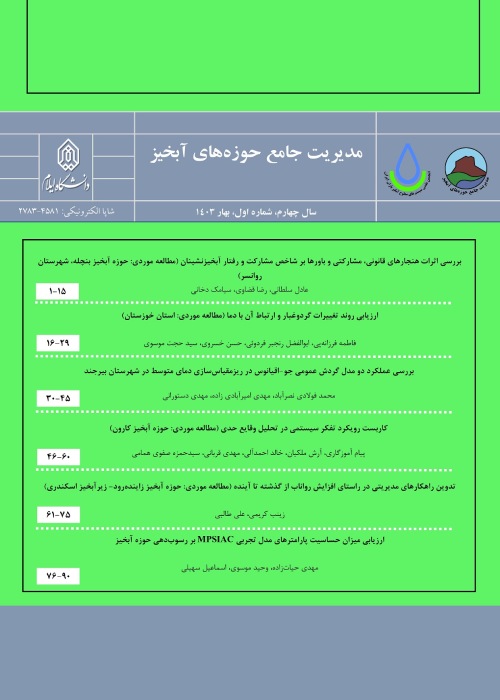Investigating factors affecting the participation and behavior of stakeholders in water and soil Conservation projects (Case of study: Benchele watershed, Ravansar city)
Water and soil resources are the most important factors in the production of energy needed for humans. In order to protect water and soil resources, different management methods are applied according to the conditions of each region. The participation of all watershed residents and changing their behavior will be one of the basic tools of any sustainable management plan. Since norms affect the participation and behavior of local communities; the purpose of this research is to investigate the norms affecting the participation and behavior of watershed residents in the implementation of water and soil protection projects.
This research was done by descriptive-analytical method. For this purpose, Benchele watershed in Ravansar city was selected as the study area. A questionnaire was used to collect field data. The statistical population of this research was all heads of households of watershed residents in this area, numbering 569 people. Among them, using Cochran's formula and matching with Morgan's table, 229 people were directly questioned by simple random method and completed the questionnaires. Spearman's correlation tests and stepwise regression were used to analyze the data. The focus of the questions was focused on three independent variables (legal norms, normative beliefs and participatory norms) and two dependent variables (participation and behavior of watershed residents). In the data analysis section, descriptive statistics (frequency, percentage, average, etc.) and inferential statistics (Spearman's correlation test and step-by-step regression) were used. Before performing the regression to check the collinearity test, the degree of collinearity of the independent variables was examined. Also, standardized beta values were used to determine the relative importance of each independent variable in the participation and behavior of watershed residents.
The mean ranking results of each of the items of legal norms affecting the participation and behavior of watershed residents in water and soil protection projects show that the items of "people who damage water and soil resources should be fined" and "existing laws are useful to convince people in the field of protecting water and soil resources" have the greatest and least impact on legal norms with the participation and behavior of watershed residents, respectively. The results of the mean ranking of each of the items of normative beliefs affecting the participation and behavior of watershed residents in water and soil protection projects show that the highest ranking average is related to "society expects me to take care of water resources" and do not destroy the soil" and the lowest rating is related to "experts expect me not to destroy the soil". The mean ranking results of each items of the participation norm effective on the participation and cooperative behavior of watershed residents in water and soil protection projects show that from their point of view, the item "voluntarily participates in the construction of sediment dams" and the statement "I am willing to pay for the implementation of water and soil protection projects", respectively, have the greatest and least impact on the participation and behavior of watershed residents in water and soil protection projects. The results of Spearman's test showed that all three independent variables of legal norms, normative beliefs, and participatory norms have a positive and significant relationship with the participation and behavior of watershed residents. Also, the regression results and beta values showed that, respectively, the indicators of legal norms, normative beliefs, and participatory norms had the highest priority in the participation and behavior of local communities.
The results showed that about 66% of watershed residents have moderate to low participation and cooperative behavior. The mean ranking results of each of the watershed residents' participation and their behavior to participate in water and soil protection projects show that the watershed residents' care of the projects after its completion, participation in the mortar dam construction project Mortar-cement dam has the greatest effect on their participation and cooperative behavior. Also, the items of participation in the construction of gabion dam project and the desire and intention of watershed residents towards water and soil protection had the least effect on the participation and behavior of watershed residents towards water and soil protection. In general, paying attention to the norms, beliefs, behaviors and attitudes of local communities should be on the agenda of managers and planners to pave the way to protect water and soil resources.
- حق عضویت دریافتی صرف حمایت از نشریات عضو و نگهداری، تکمیل و توسعه مگیران میشود.
- پرداخت حق اشتراک و دانلود مقالات اجازه بازنشر آن در سایر رسانههای چاپی و دیجیتال را به کاربر نمیدهد.



